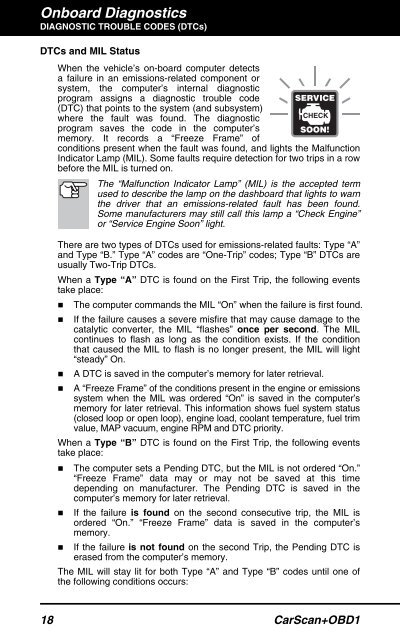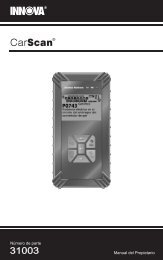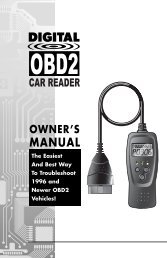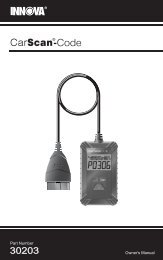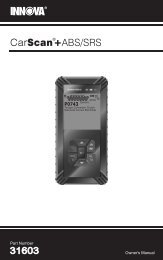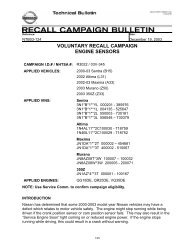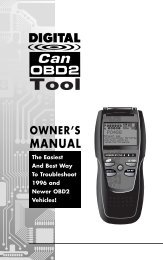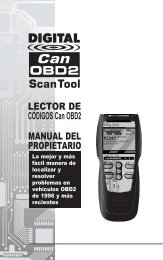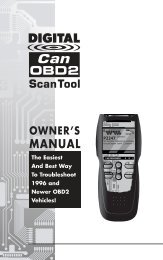Manual PDF - Innova Pro
Manual PDF - Innova Pro
Manual PDF - Innova Pro
Create successful ePaper yourself
Turn your PDF publications into a flip-book with our unique Google optimized e-Paper software.
Onboard Diagnostics<br />
DIAGNOSTIC TROUBLE CODES (DTCs)<br />
DTCs and MIL Status<br />
When the vehicle’s on-board computer detects<br />
a failure in an emissions-related component or<br />
system, the computer’s internal diagnostic<br />
program assigns a diagnostic trouble code<br />
(DTC) that points to the system (and subsystem)<br />
where the fault was found. The diagnostic<br />
program saves the code in the computer’s<br />
memory. It records a “Freeze Frame” of<br />
conditions present when the fault was found, and lights the Malfunction<br />
Indicator Lamp (MIL). Some faults require detection for two trips in a row<br />
before the MIL is turned on.<br />
The “Malfunction Indicator Lamp” (MIL) is the accepted term<br />
used to describe the lamp on the dashboard that lights to warn<br />
the driver that an emissions-related fault has been found.<br />
Some manufacturers may still call this lamp a “Check Engine”<br />
or “Service Engine Soon” light.<br />
There are two types of DTCs used for emissions-related faults: Type “A”<br />
and Type “B.” Type “A” codes are “One-Trip” codes; Type “B” DTCs are<br />
usually Two-Trip DTCs.<br />
When a Type “A” DTC is found on the First Trip, the following events<br />
take place:<br />
• The computer commands the MIL “On” when the failure is first found.<br />
• If the failure causes a severe misfire that may cause damage to the<br />
catalytic converter, the MIL “flashes” once per second. The MIL<br />
continues to flash as long as the condition exists. If the condition<br />
that caused the MIL to flash is no longer present, the MIL will light<br />
“steady” On.<br />
• A DTC is saved in the computer’s memory for later retrieval.<br />
• A “Freeze Frame” of the conditions present in the engine or emissions<br />
system when the MIL was ordered “On” is saved in the computer’s<br />
memory for later retrieval. This information shows fuel system status<br />
(closed loop or open loop), engine load, coolant temperature, fuel trim<br />
value, MAP vacuum, engine RPM and DTC priority.<br />
When a Type “B” DTC is found on the First Trip, the following events<br />
take place:<br />
• The computer sets a Pending DTC, but the MIL is not ordered “On.”<br />
“Freeze Frame” data may or may not be saved at this time<br />
depending on manufacturer. The Pending DTC is saved in the<br />
computer’s memory for later retrieval.<br />
• If the failure is found on the second consecutive trip, the MIL is<br />
ordered “On.” “Freeze Frame” data is saved in the computer’s<br />
memory.<br />
• If the failure is not found on the second Trip, the Pending DTC is<br />
erased from the computer’s memory.<br />
The MIL will stay lit for both Type “A” and Type “B” codes until one of<br />
the following conditions occurs:<br />
18 CarScan+OBD1


